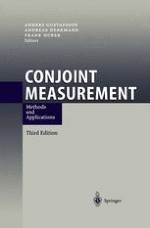2003 | OriginalPaper | Buchkapitel
Conjoint Choice Experiments: General Characteristics and Alternative Model Specifications
verfasst von : Rinus Haaijer, Michel Wedel
Erschienen in: Conjoint Measurement
Verlag: Springer Berlin Heidelberg
Enthalten in: Professional Book Archive
Aktivieren Sie unsere intelligente Suche, um passende Fachinhalte oder Patente zu finden.
Wählen Sie Textabschnitte aus um mit Künstlicher Intelligenz passenden Patente zu finden. powered by
Markieren Sie Textabschnitte, um KI-gestützt weitere passende Inhalte zu finden. powered by
Conjoint choice experimentation involves the design of product profiles on the basis of product attributes specified at certain levels, and requires respondents to repeatedly choose one alternative from different sets of profiles offered to them, instead of ranking or rating all profiles, as is usually done in various forms of classic metric conjoint studies. The Multinomial Logit (MNL) model has been the most frequently used model to analyze the 0/1 choice data arising from such conjoint choice experiments (e.g., Louviere and Woodworth 1983; Elrod, Louviere and Davey 1992). One of the first articles describing the potential advantages of a choice approach for conjoint analysis was by Madanski (1980). His conclusion was that conjoint analysts could adopt the random utility model approach to explain gross trends or predilections in decisions instead of each person’s specific decision in each choice presented. The real breakthrough for conjoint choice came with the Louviere and Woodworth (1983) article in which they integrated the conjoint and discrete choice approaches.
